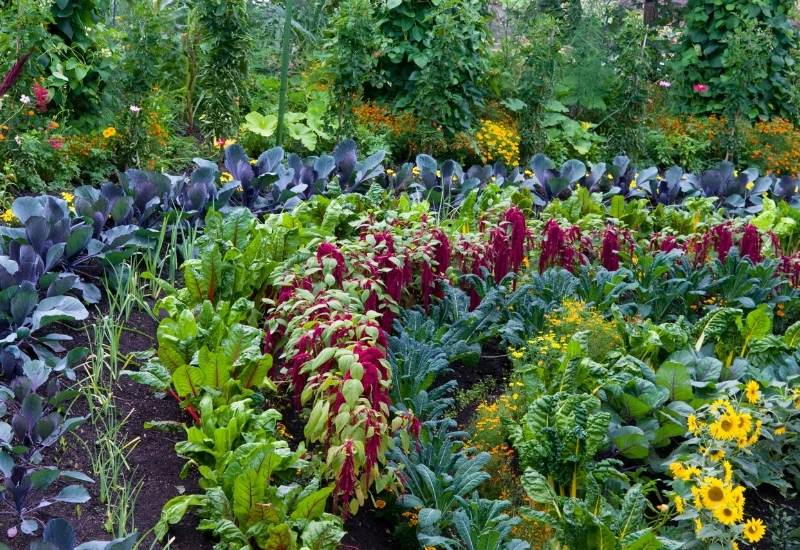
You know what they say, there’s more to flowers than meets the eye. Sure, they’re gorgeous to look at, and their sweet fragrances can lift anyone’s spirits, but did you know that some flowers can do more than just dazzle our senses? In fact, many flowers can be extremely beneficial when planted in or near a vegetable garden.
Companion planting flowers with your veggies can help you maintain soil nutrients, prevent erosion, and even attract key pollinators and beneficial insects while repelling the nasty ones.
And here’s the kicker – some of these beneficial flowers might not be the prettiest or sweetest smelling ones out there, but they sure do pack a punch when it comes to helping your veggies grow.
Some of these beneficial flowers are esthetically beautiful and sweet-smelling, while others might not seem so pleasing to us, yet still benefit the vegetables growing near them.
If this sounds like something you are curious about, you might be wondering what are some of the best flowers to plant in your vegetable garden.
Two of the best friends for a vegetable garden include French marigolds and nasturtiums. Though this is just the tip of a very fragrant iceberg.
To truly find the best pairings and companion planting flowers for your garden, you’ll need to take a closer look at the best cultivars, growing conditions, seasonal timing and determine how close or far the flowers should be planted from the most popular garden vegetables.
But trust me; the results are worth it. Your garden will thank you for this beautiful and functional relationship between flowers and veggies.
So, are you ready to take your veggie patch to the next level with some floral friends? Let’s dive in and discover the benefits of mixing flowers and vegetables together and I’ll also share some of my favorite companion flowers get along well with vegetables.
Why You Should Always Plant Flowers In Your Vegetable Plot?
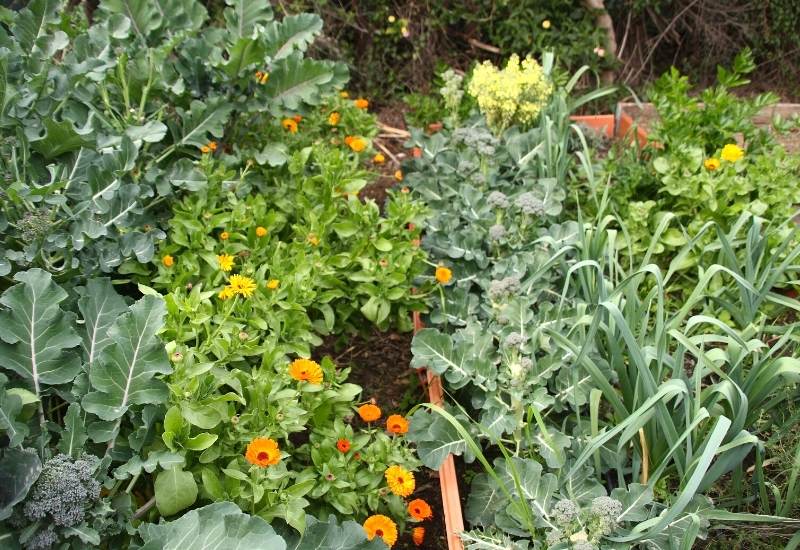
Beyond simple visual esthetics flowers in a vegetable garden are typically used to attract beneficial insects, repel harmful insects as well as to create a fragrant border to discourage certain animals.
Can Flowers Be Used For Crop Rotation?
Crop rotation was one of the key factors that helped medieval Europe embraces the renaissance.
When one type of plant is grown over and over again in the same soil, it can deplete key nutrients, leading to lesser yields year after year as well as planting beds that are more prone to common plant diseases or fungal infections.
Planting flowers as part of a garden rotation plan can let the soil replenish while reducing soil loss due to erosion, while also giving you something attractive to cut for kitchen and table bouquets.
11 Of The Best Flowers To Benefit A Vegetable Garden
Planting flowers in or as a border surrounding your vegetable garden can have several advantages including repelling pests, attracting common garden pests as a sacrificial plant, or boosting the surrounding soil nutrients.
All the while offering up beautiful flowers for fresh-cut table bouquets.
Here are 11 of the best variety of flowers to grow as companion plants in or near your vegetable garden to deter pests, attract beneficial insects, and improve your soil.
1. Marigolds

Marigolds are a somewhat diverse family of flowers that are known for their aromatic presence.
Marigolds are seen as being very beneficial for plants like tomatoes as well as many other plants. While the more common African marigolds do have a minor aromatic and visual value, French marigolds like Tashkent are more fragrant and do a better job of repelling moths, as well as many of the flies, like carrot flies, that plague many common garden plants.
French marigolds help to repel a wide range of insects including Aphids, Cabbage Maggots, Potato Beetles, Corn Earworms & Cutworms, Cucumber Beetles, Flea Beetles, Japanese Beetles, Nematodes and Squash bugs.
At the same time, their aromatic nature helps draw in a wide range of beneficial pollinators. They also tend to be visually stunning for cutting table bouquets.
Here are some common garden crops that enjoy marigold companions:
Marigolds should not be planted near beans.
2. Calendula
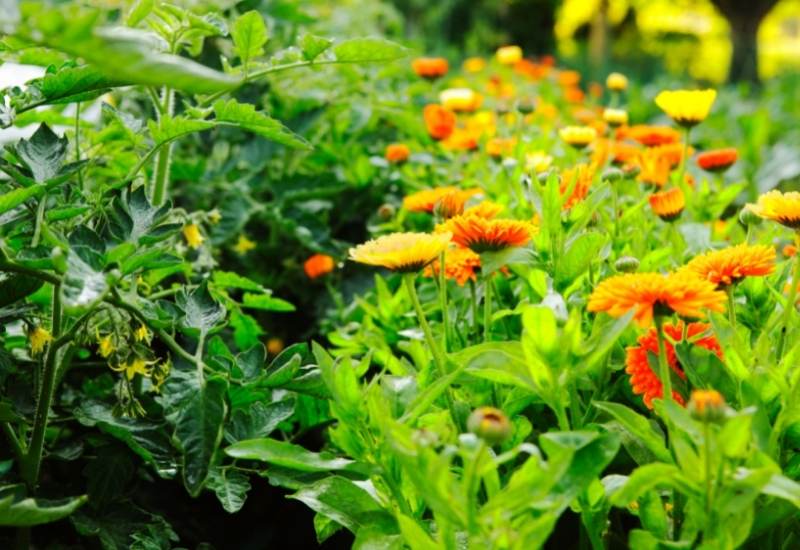
Calendula is a very popular annual flower grown in many vegetable gardens. It looks a little bit like a bright yellow daisy and can grow up to 24 inches tall.
One of the ways that calendula flowers help vegetable gardens is with their sticky sap that first attracts and then traps smaller insects like aphids and whiteflies, which then keeps them off of nearby crops.
At the same time, calendula flowers also help to attract many types of pollinators and other beneficial insects including ladybugs, and hoverflies, as well as green lacewings that help kill other pests that often plaque vegetable gardens.
In the south and the sunbelt where winter erosion is an issue calendula flowers can be planted in the fall after the harvest to help hold the soil in place.
Calendula is most beneficial for
3. German Chamomile
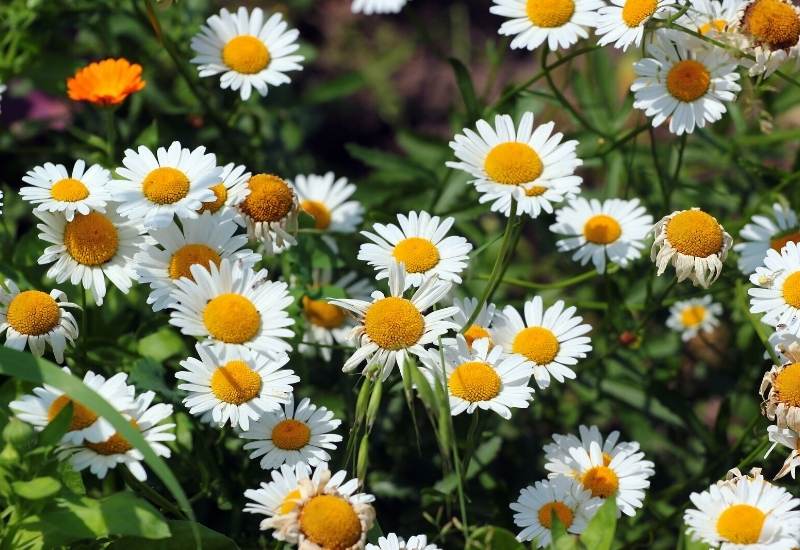
Also prized as a medicinal plant in its own right, German chamomile has several benefits for vegetable gardens.
When planted as a border or allowed to grow in between rows of vegetables German chamomile helps attract beneficial insects and pollinators.
At the same time, German chamomile also extends down deep roots that help pull nutrients and loosen the subsoil.
The bulk of these nutrients remain in the plant, which then engages with the topsoil layers when it dies back. This also makes German chamomile a great option for larger gardens and hobby farms that employ a rotation strategy with fallow sections.
5. Nasturtium
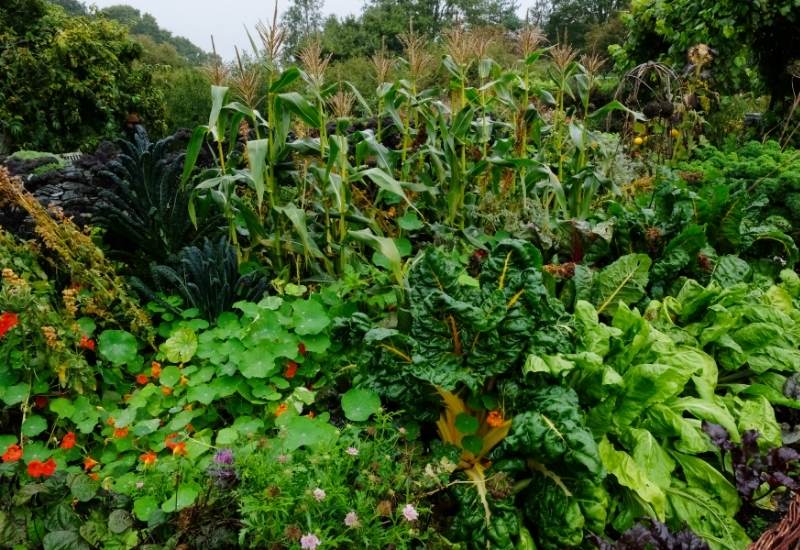
Nasturtium is technically an annual herb that has peppery leaves as well as vibrant edible flowers. It is known for giving off a strong odor that helps repels pests.
When trained it can sprawl which also makes it a good companion for vegetables like cucumber.
When left to sprawl on the ground it makes a great soil cover providing shade and helping to preserve moisture levels for taller vegetables like tomatoes and peppers.
Then when it dies back the nutrients add mulch value to the upper layers of the soil.
The following all make excellent nasturtium companions:
6. Borage
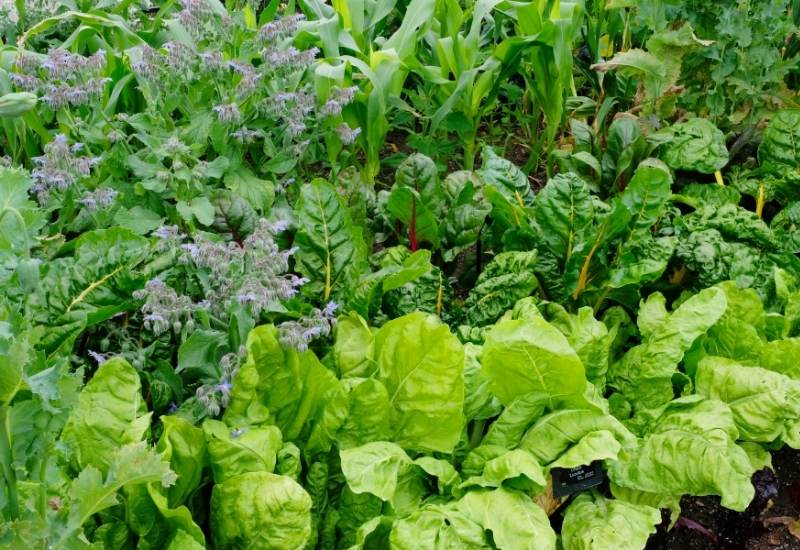
Borage is an annual flower that makes a great addition to many vegetable gardens. The flower itself is edible and can add color as well as herbaceous flavor to summer salads.
Borage is also easy to grow and will self-seed if left to its own devices, giving you repeat crops every year out of just one sowing.
Borage also helps to attract bees and other beneficial pollinators to your garden, which will help improve the yield of fruiting plants.
It also acts as a trap crop for aphids, while also attracting insectivore birds to your garden. It can also help repel some of the moths and caterpillars like hornworms that attack tomatoes.
When we look below the surface, we find that borage also helps to break up and aerates the soil with a diverse root system.
At the same time, it is known to be a dynamic accumulator of nutrients. At the end of the season, you can harvest the borage as it dies back to add key nutrients to your fall and winter compost pile.
Plant borage with these garden vegetables to keep crops healthy, fertile, and pest-free:
7. Sunflowers
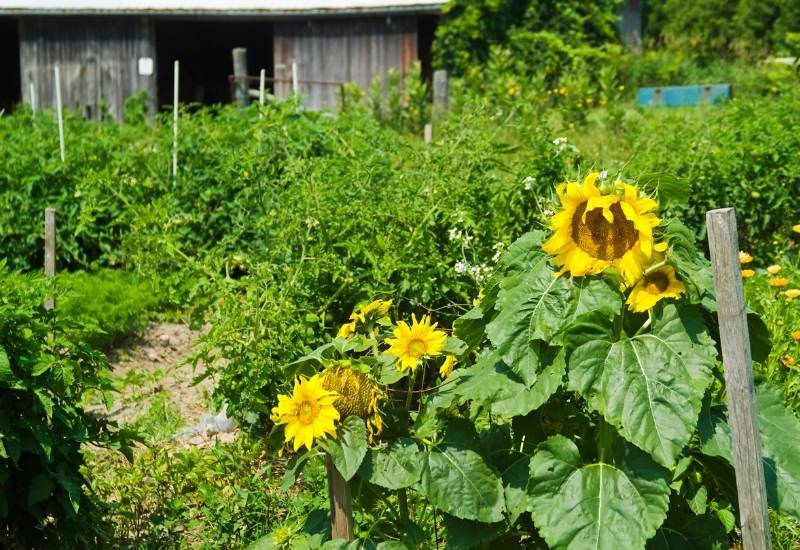
Sunflowers are beautiful and arguably majestic to behold, they also do a good job of attracting beneficial pollinators to your vegetable garden. For some garden crops, they can also provide shade, which makes them a good companion for late summer and early fall greens.
They also work well as a functional border and when the season is done you can harvest their seeds as a snack as well as compost their stalks to give your compost bin added carbon and aerations.
Sunflowers can also serve as a pole or stake for vining vegetables like beans and cucumbers. Just bear in mind that they tend to have a negative allelopathic effect on some plants. You should avoid planting sunflowers with pole beans, bush beans, and potatoes.
Sunflower makes excellent companion plant for these vegetables
Sunflowers should not be grown near
8. Lavender
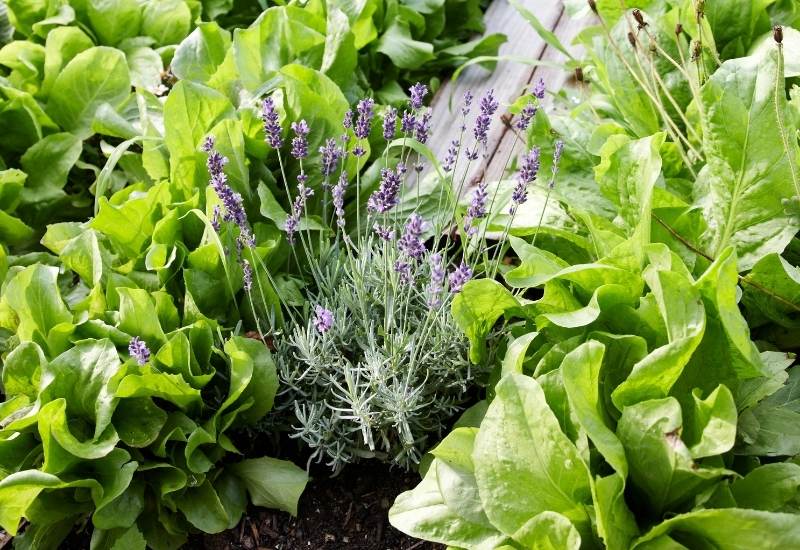
Lavender is a flower with edible and medicinal benefits used the world over. This makes it a valuable addition to your garden on its own. Lavender also helps attract in beneficial pollinators including honey bees and bumblebees that move from flower to flower.
This makes them a great addition to a garden where pollinator population numbers are low and you want to encourage bees to stay in your garden pollinating plants as they skip from lavender flower to lavender flower.
Lavender can be planted near
Lavender should not be planted near mint.
9. Lupins
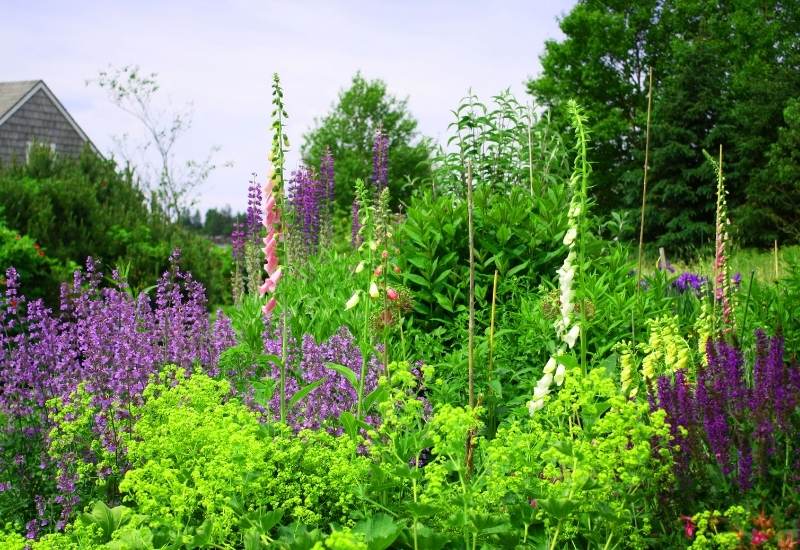
lupins are a perfect flower to plant next to vegetables like tomatoes, peppers, greens, sweet corn that require high nitrogen levels. lupins help fix nitrogen very much like how legumes such as peas and beans do. It essentially captures nitrogen from the air and deposits it in the soil in nodules near the roots.
This makes lupins a great flower for restoring a depleted field in a crop rotation cycle, or as a companion for other heavy-feeding nitrogen-loving vegetables
These vegetables are happy companions to lupines
10. Comfrey

Comfrey is a perennial flower that develops an expansive leaf structure as it grows. It develops a very deep taproot system. This makes it better as a border plant than something that will live inside the actual planting bed.
Comfrey’s flowers help attract beneficial pollinators and may also help attract insects that prey on pests.
Slugs and snails are also attracted to comfrey, which makes it a good sacrificial plant for controlling these garden pests in wet conditions.
Just make sure to pick the slugs and snails off from time to time to keep the population low.
Comfrey’s leaves can also be cut back at the end of summer to make a nitrogen-rich addition to your compost pile or mulch for nitrogen-depleted planting beds in your garden.
If you are adept at making your own natural fertilizers comfrey’s leaves can be cut back in mid-summer and used to make a special organic fertilizer liquid.
Since the taproot is deep and strong the leaves will grow back on an established plant despite aggressive cutting.
Comfrey can grow well with
11. Cosmos
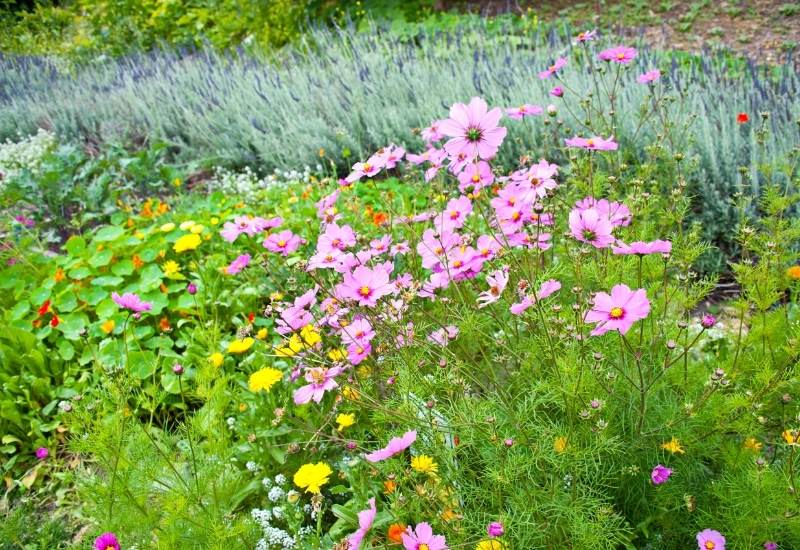
Cosmos are often thought of as being a beautiful cutting flower. Though they also help to attract beneficial pollinators to your garden. This makes them a great addition for areas where natural pollinator populations are low.
Cosmos are also very attractive to aphids and other small garden insect pests which can help keep them off of other aphid-sensitive plants.
Cosmos can be planted with
Is It A Good Idea To Plant Perennial Flowers In My Garden?
Perennials like comfrey can help boost your garden by attracting beneficial pollinators or helping to manage common garden pests.
Though they are a true investment and once established they can be very hard to remove effectively.
This can limit your options years later if you ever want to change your garden’s layout or rotate vegetables to improve soil nutrient levels. With this in mind, it is better to plant perennials like comfrey as a border rather than in the actual garden planting beds.
What Is A Sacrificial Plant?
The term “Sacrificial Plant” refers to a plant that helps attract common garden pests like slugs, snails, aphids or hornworms.
These insects prey on the plant rather than your cherished vegetables. Though you will still need to periodically remove these pests from the sacrificial plant for it to truly be beneficial.
Otherwise, the insect pests will simply thrive on the plant, growing in numbers and eventually spreading back to the vegetables you were hoping to protect.
What Flowers Should Not Be Planted Near Vegetables?
There are some plants and flowers that grow vigorously and can choke out garden plants or potentially steal vital nutrients from the garden soil.
Flowers you shouldn’t plant near vegetables includes: Clover, Golden Creeping Jenny or Moneywort, Mazus Reptans, Phlox and Red Creeping Thyme.
Companion Planting Flowers With Vegetables Can Be Fun And Beneficial
There are some great flowers out there that will help attract beneficial insects to your garden or keep pests away. A few will even act as sacrificial plants while serving as a colorful border. A few even help fix nitrogen in the soil to help boost heavy-feeding vegetables and herbs.
For example, let’s say that you have tomatoes and peppers that benefit from above-average pollinator populations, then pairing them with flowers like borage cosmos can bring in bees, butterflies.
If your garden has a frequent problem with snails and slugs every year, then a border of perennial comfrey might be just the thing to keep them off your peppers and squash.
With some handpicking the population can stay low. Then the leaves can contribute to the nitrogen level of the compost pile in the fall.

Written By
Amber Noyes
Amber Noyes was born and raised in a suburban California town, San Mateo. She holds a master’s degree in horticulture from the University of California as well as a BS in Biology from the University of San Francisco. With experience working on an organic farm, water conservation research, farmers’ markets, and plant nursery, she understands what makes plants thrive and how we can better understand the connection between microclimate and plant health. When she’s not on the land, Amber loves informing people of new ideas/things related to gardening, especially organic gardening, houseplants, and growing plants in a small space.

Your knowledge is very helpful, thank you for helping us people that are not too good at growing vegetable gardens.
Thank you so much for your kind words! I’m glad that I can be of help to you, especially when it comes to vegetable gardening. Growing a successful vegetable garden can be a rewarding experience, and I’m here to assist you every step of the way.
Remember, gardening is a continuous learning process, and even experienced gardeners face challenges along the journey. Don’t worry if you’re not too confident in your gardening skills right now. With a little bit of guidance and practice, you’ll become more proficient over time.
If you ever have any specific questions or need advice on any aspect of vegetable gardening, feel free to ask. I’m here to share my knowledge and offer support to make your gardening endeavors more enjoyable and successful. Happy gardening, and may your vegetable garden flourish with delicious produce!
This article was so informative.
I am planting a raised garden (24″) for the first time.
I love the idea of companion flowers that can help our vegetables and look beautiful at the same time. The added benefit to bees and butterflies warms my heart! Thank you!
Great information. I’ve been gardening for many years. This year I’ve spent more time with natural plants that deter pests and squirrels, etc. Whatever I do with my gardening, it’s always like therapy for me. Getting advice and new ideas is so nice. Thank you.
Hi Amber.
Thanks for your post…and lovely smile.😁
My wife and I are struggling to establish a garden here in Southern Mississippi. The ground has so much hard clay. We have a tiller and tractor. Any ideas on how to loosen and enrich the soil so that we can avoid a raised garden?
Thank you for your time.
Scott and Marie
I think this article might be useful for you https://www.gardeningchores.com/improving-clay-soils/